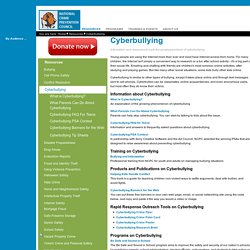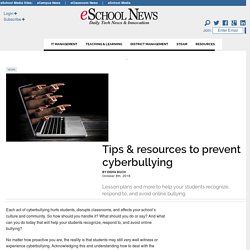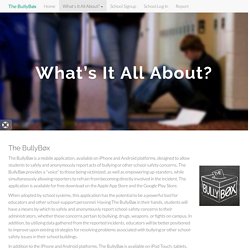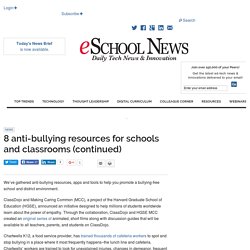

eSafety Commissioner. This video is a dramatic scenario used to provoke thought about displaying personal resilience while online.

It features a teenage female locking herself in a bathroom to avoid four female peers. The females are played by actors. Stacey runs down an alley, pursued by a group of girls. Stacey runs into a community centre bathroom and locks the door of her stall just as a youth worker exits the second stall Veronica, the group leader, pushes the bathroom door open but stops abruptly when she sees the youth worker at the sink.
Stacey’s phone pings with a message notification. The girls stand outside on their phones, texting Stacey. Stacey’s phone pings repeatedly, with the texts popping up in conversation bubbles around her, reading “feelin @ home in the toilet w/all the other scum??” As the notifications stream in rapidly, Stacey gets increasingly agitated. Stacey stares at the quote, its meaning sinking in. Veronica and her group enter the community centre, heading for the bathroom. Cyberbullying. Internet Safety 101: Statistics. Key Findings: -Nearly half of young people (47%) have received intimidating, threatening or nasty messages online -Children and young people are using social media for longer periods, and using multiple profiles -Underage (U13) use of social media is common place -There is a connection between intensive social media use and mental ill health.

(Safety net: The impact of cyberbullying on children and young people’s mental health, Feburary 2018) Summary report hereMore youths experienced cyberbullying on Instagram than any other platform at 42 percent, with Facebook following close behind at 37 percent. Snapchat ranked third at 31 percent. While the survey participants use YouTube more than any other platform, the video-focused social media was only responsible for 10 percent of the reported cyber bullying. Seventy-one percent of the survey participants said that social media platforms do not do enough to prevent cyberbullying.
Cyberbullying — National Crime Prevention Council. Young people are using the Internet more than ever and most have Internet access from home.

For many children, the Internet isn't simply a convenient way to research or a fun after school activity - it's a big part of their social life. eSafety: How to Keep Kids Safe Online - WhoIsHostingThis.com. What Is Cyberbullying. Bullying & abuse Archives - Netsafe – Online Safety Help and Advice for New Zealanders. Helping kids survive bullying and other trauma. The Parent’s Guide to Cyberbullying. Where Kids Find Hate Online.
The Parent’s Guide to Cyberbullying. Tips & resources to prevent cyberbullying. Each act of cyberbullying hurts students, disrupts classrooms, and affects your school’s culture and community.

So how should you handle it? What should you do or say? And what can you do today that will help your students recognize, respond to, and avoid online bullying? No matter how proactive you are, the reality is that students may still very well witness or experience cyberbullying. Acknowledging this and understanding how to deal with the aftermath is just as important as knowing how you can prevent it. Changing the culture of how we both prevent and respond to cyberbullying can lead to powerful effects in the larger community. Turn Down the Dial on Cyberbullying (9-12) View.commonsense-email. Bullying & Ostracism. What’s It All About? Click the images to the left to view the data that can be collected, analyzed, and used to formulate and evaluate school policy.

Managing all of your bullying-related data in one spot....saving administrators time and effort!! We at MostBeastlyStudios realize how important tangible data and numbers can be for school districts, particularly as it pertains to highly controversial topics such as bullying. In addition, we recognize how busy school administrators are. Therefore, we have developed a tool for the collection and analysis of data from reports submitted through the BullyBox, as well as subsequent investigations carried out by school personnel. Af the conclusion of their investigation, the administrator or other school personnel, can access their school's individual page to input any data available. ** It should be noted that the data-analysis web tool can be used to document verbal reports, hand-written reports, as well as reports from The BullyBøx.
Anonymous Alerts – Anti-bullying App and Bullying Incident Reporting. Student anti-bullying app Anonymous Alerts® anti-bullying app and safety reporting system is simple, secure and enables students to quickly report incidents related to bullying, cyberbullying, student depression, family problems, self-harm, drugs, gang-related issues, harassment, weapons on campus or unusual student behavior which may warrant immediate attention by school officials.

The reporter of the incident can establish anonymous 2-way communications™ with school officials. Anonymous Alerts® encourages those who feel vulnerable or less confident to speak up without fear of reprisal. Home. Welcome. Cyberbullying Toolkit. An Anti-Cyberbullying Toolkit for Educators This free toolkit has the resources schools need to take an effective stand against cyberbullying.

Rely on it to start your year off right. A THIN LINE, MTV's sexting, cyberbullying, digital dating abuse campaign : www.athinline.org. 8 anti-bullying resources for schools and classrooms. We’ve gathered anti-bullying resources, apps and tools to help you promote a bullying-free school and district environment.

ClassDojo and Making Caring Common (MCC), a project of the Harvard Graduate School of Education (HGSE), announced an initiative designed to help millions of students worldwide learn about the power of empathy. Cyberbullying flowchart 2015.